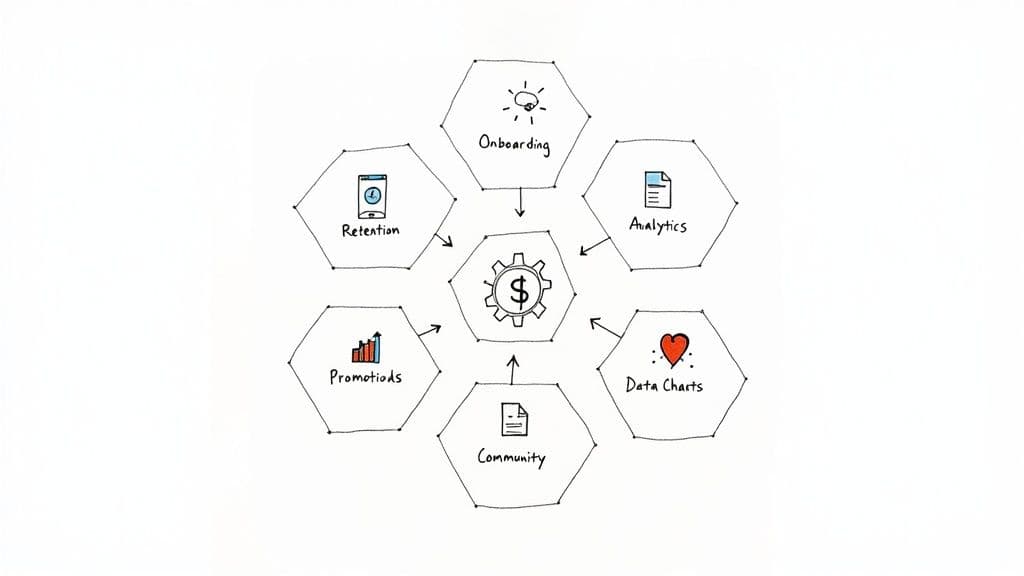The subscription economy is booming, but success is no longer about simply having a recurring payment option. To thrive in 2025 and beyond, businesses must master a sophisticated set of strategies that turn one-time buyers into loyal, long-term subscribers. The difference between stagnant growth and a thriving community lies in the details: from how you price your service to how you welcome new members. Generic tactics are failing. Instead, a deliberate approach grounded in proven subscription model best practices is essential for building sustainable revenue and delighting your customers.
This guide moves beyond theory to provide a comprehensive roadmap for refining your subscription strategy. We will break down eight critical best practices, offering actionable insights and real-world scenarios to help you implement them effectively. You will learn how to structure value-based pricing, create a frictionless onboarding process, and proactively reduce churn before it happens. We will also explore techniques for delivering continuous value, personalising the user journey, and leveraging data to make smarter decisions.
To gain inspiration and see how these principles are applied across different industries, it’s helpful to explore various successful approaches. Analysing these Top Subscription Model Examples can provide a practical framework for your own business. Whether you are a digital coach, a content creator monetising your work, or an online course instructor, mastering these concepts will form the bedrock of your success. This article is your blueprint for unlocking consistent growth and building a resilient subscription business that stands the test of time. Let’s dive into the core practices that will upgrade your model from a simple payment plan to a powerful engine for customer loyalty and predictable income.
1. Value-Based Pricing Strategy
One of the most impactful subscription model best practices involves shifting your pricing focus from internal costs to external customer value. A value-based pricing strategy anchors your subscription fees to the tangible benefits and outcomes your service delivers. Instead of asking, "What does it cost us to provide this?" you ask, "What is this result worth to our customer?" This customer-centric approach aligns your revenue directly with the success and satisfaction of your members.

21f23b39-64a6-4928-8bd3-9e46f18c13b9.jpg
This method requires a deep understanding of your audience, whether they are fitness clients achieving health milestones or entrepreneurs scaling their business. By quantifying the value you provide, you can confidently set prices that reflect that contribution, leading to higher revenue and more loyal customers who feel the price is fair for the benefits received.
Why It Works
Value-based pricing is effective because it directly ties your product's price to its perceived worth. This decouples you from a race-to-the-bottom with competitors and allows you to capture a share of the value you create for your subscribers.
For example, HubSpot organises its pricing tiers around business growth stages. A small startup pays less for basic marketing tools, while a large enterprise pays a premium for advanced automation and analytics that drive significant revenue, demonstrating a clear link between price and value delivered. Similarly, Adobe Creative Cloud justifies its subscription cost based on the immense professional value its software suite provides to designers, photographers, and video editors.
How to Implement It
Successfully adopting this strategy involves continuous research and clear communication.
- Conduct Customer Research: Regularly use surveys, interviews, and feedback forms to understand what your members value most. Ask them directly what outcomes they hope to achieve with your service.
- Analyse Usage Data: Monitor which features are used most frequently by your highest-value customers. This data validates what parts of your service are most critical and justifies premium pricing for tiers that include them.
- Structure Clear Tiers: Design your pricing page to explicitly state the unique value proposition of each subscription level. Use benefit-oriented language that speaks to specific customer goals.
- Test and Iterate: Before a full rollout, test new pricing structures on a small segment of new customers to gauge their reaction and measure conversion rates.
Key Insight: Your pricing is a core part of your product's story. Value-based pricing ensures that the story you tell is about customer success, not your own operational costs. While it can be combined with other approaches, such as promotional pricing strategies for acquisition, the underlying value perception should remain the foundation.
2. Seamless Onboarding Experience
The first few moments after a customer signs up are the most critical in their entire subscription lifecycle. A seamless onboarding experience is designed to guide new subscribers from their initial registration to their first "Aha!" moment-the point where they realise the true value of your service. This process is a cornerstone of subscription model best practices because it directly combats early churn by helping users quickly understand, adopt, and integrate your service into their routine.

645e4b81-3dbf-4e9b-bcea-4fa953acc99b.jpg
Effective onboarding reduces the time-to-value, boosting initial engagement and setting the stage for long-term loyalty. Whether you're a fitness coach guiding a client through their first workout plan or an educator introducing a student to a new course platform, a smooth introduction ensures they feel supported and confident from day one. To foster lasting customer relationships and reduce early churn, establishing an effective customer onboarding process is paramount.

embed
Why It Works
A structured onboarding process works because it transforms a potentially overwhelming new service into a guided, rewarding journey. It prevents the common scenario where a new user signs up, feels lost, and cancels before ever experiencing the core benefits. By actively showing them how to succeed, you build momentum and investment.
For instance, Slack excels with a simple team setup wizard that encourages users to invite colleagues and create channels immediately, demonstrating its collaborative value instantly. Similarly, Canva asks new users about their design goals (e.g., social media post, presentation) and then presents relevant templates and a brief tool introduction, making a powerful design suite feel accessible to beginners.
How to Implement It
Building a successful onboarding flow requires a strategic, user-centric approach focused on achieving quick wins.
- Map Critical User Actions: Identify the key actions a subscriber must take within their first session or week to experience value. Focus your onboarding on guiding them through these specific steps.
- Use Progressive Disclosure: Don't overwhelm users with every feature at once. Introduce tools and information contextually as they are needed. Use tooltips, welcome modals, and short guided tours.
- Personalise the Journey: Ask simple questions at sign-up to tailor the experience. For example, a course creator can ask about a student's skill level to recommend the right starting module.
- Test and Refine: Continuously A/B test different onboarding flows. Analyse user behaviour to see where they get stuck or drop off, and then iterate on those friction points to improve completion rates.
Key Insight: Onboarding is not just a tutorial; it's the first promise you deliver on. A great onboarding experience confirms the customer's decision to subscribe and sets a positive tone for the entire relationship.
3. Proactive Churn Prevention
A cornerstone of sustainable subscription model best practices is shifting from a reactive to a proactive stance on customer churn. Proactive churn prevention involves implementing systems to identify at-risk customers before they decide to cancel and then taking targeted, pre-emptive action to retain them. This strategy requires analysing customer behaviour patterns, engagement metrics, and satisfaction indicators to predict and mitigate potential cancellations.

85fd64b6-1034-44b2-aad4-62975efe014d.jpg
Instead of waiting for the "I want to cancel" email, you actively monitor for signs of disengagement, such as a drop in usage, ignored notifications, or a lack of feature adoption. By intervening at the right moment with the right message or support, you can address a customer's underlying issues, demonstrate your value, and steer them back towards success and loyalty.
Why It Works
Proactive prevention is far more cost-effective and successful than trying to win back a customer who has already made the decision to leave. It addresses the root cause of dissatisfaction while the relationship is still salvageable, strengthening the customer's connection to your service.
For instance, Netflix analyses viewing patterns and if a user hasn't logged in for a while, it sends targeted "we miss you" emails with content recommendations to re-engage them. Dropbox alerts users when they approach their storage limit, a critical moment where they can either see the limitation as a reason to leave or as an opportunity to upgrade and get more value. Similarly, Mailchimp sends alerts when an email campaign underperforms, offering optimisation tips that help users achieve better results and reinforce the platform's value.
How to Implement It
Successfully implementing this strategy requires a data-driven approach and automated, yet personalised, outreach. For a modern approach to reducing cancellations, consider the benefits of building an AI retention bot to combat customer churn, which can help automate some of these processes.
- Define Early Warning Indicators: Identify the key metrics that signal a customer is losing interest. This could be declining login frequency, low feature usage, or unanswered support tickets.
- Create Automated Workflows: Set up triggered email sequences or in-app messages based on risk levels. A low-risk user might get a helpful tip, while a high-risk user could receive a personal check-in from a customer success manager.
- Train Your Team: Equip your customer-facing teams with the skills to handle retention conversations. They should be trained to listen, diagnose problems, and reiterate the value of your service.
- Segment Your Outreach: Don't treat all at-risk users the same. Tailor your interventions based on the customer's subscription tier, usage history, and the specific warning signs they exhibit.
Key Insight: Proactive churn prevention transforms your customer service from a cost centre into a revenue-protection engine. By identifying and solving problems before they lead to cancellation, you not only save a subscriber but also create a more loyal advocate for your brand. Deepen your knowledge with these customer retention best practices to build a robust framework.
4. Flexible Subscription Management
Empowering customers with control over their own subscription is a cornerstone of modern, trust-based business relationships. Flexible subscription management involves providing users with an easy-to-use, self-service portal to modify their plans. This includes options to upgrade, downgrade, pause, or even cancel their subscription without needing to contact customer support. This transparency builds significant trust and directly addresses evolving customer needs.

8914b66b-948f-4160-ba66-53934883ad7d.jpg
When a customer's circumstances change, a rigid subscription model forces a binary choice: keep paying or cancel entirely. By offering flexibility, you provide a third option that accommodates their situation, which can dramatically reduce voluntary and involuntary churn. It shows you respect their autonomy and value their long-term relationship over short-term revenue, making them more likely to return or upgrade later.
Why It Works
This practice is effective because it reduces friction and aligns your service with the customer's real-life journey. Instead of creating a frustrating experience that might lead to a negative review or a chargeback, you foster goodwill. A customer who pauses their account is not a lost customer; they are a temporarily inactive one who fully intends to return.
For instance, Disney+ allows users to pause their subscription, a perfect solution for families who may not use the service during summer holidays but will reactivate it in the autumn. Similarly, Peloton members can freeze their membership when they are travelling or injured, preventing them from cancelling a service they otherwise value. This flexibility is a key part of an effective subscription model, demonstrating a company's commitment to the customer's lifestyle.
How to Implement It
Implementing a flexible management system requires a focus on user experience and clear communication.
- Make It Accessible: Ensure customers can access their subscription settings within two to three clicks from their main account dashboard. Hiding these options creates frustration and distrust.
- Clarify Implications: When a user chooses to change their plan, clearly display what features they will gain or lose. For pauses, state the exact date the subscription will resume and when billing will restart.
- Offer Retention Incentives: If a customer initiates a cancellation, you can present a last-minute offer, such as a temporary discount or a switch to a lower-cost tier, to encourage them to stay.
- Send Confirmation Emails: Always send an automated email confirming any changes made to a subscription. This provides a record for the customer and reinforces transparency.
Key Insight: Customer control is not a threat to your revenue; it's a powerful retention tool. By making it easy for subscribers to pause or downgrade, you prevent permanent churn and build the kind of trust that leads to greater lifetime value.
5. Continuous Value Delivery and Communication
One of the most critical subscription model best practices is to consistently prove your service's worth long after the initial sign-up. A subscription isn't a one-time sale; it's a relationship that requires ongoing justification. By proactively communicating the value customers receive, you reinforce their decision to remain subscribed, transforming a passive expense into an active, indispensable tool.
This means regularly showing subscribers what they are getting for their recurring fee. The goal is to make the value so tangible and obvious that the thought of cancelling feels like a genuine loss. This moves the customer relationship from transactional to collaborative, building trust and significantly reducing churn.
Why It Works
Continuous value communication combats subscription fatigue and buyer's remorse by consistently reminding users of the benefits they are enjoying. It shifts the focus from the cost of the subscription to the ROI it generates, making the recurring payment feel justified and worthwhile. This practice is essential for maintaining engagement and demonstrating ongoing improvement.
For instance, Grammarly sends weekly emails with personalised writing statistics, highlighting errors corrected and suggesting areas for improvement. This doesn't just show the app is working; it frames it as a personal writing coach. Similarly, LinkedIn Premium justifies its cost by showing users who has viewed their profile and providing InMail credits, directly linking the subscription to professional opportunities and networking power.
How to Implement It
Effectively demonstrating value requires a strategic and personalised communication plan.
- Segment Your Communications: Tailor your messages based on user behaviour. A power user might appreciate insights on advanced features, while a new user may benefit from tips on getting started.
- Use Visual Dashboards: Create an in-app or members-only dashboard that visually summarises key metrics, like money saved, time saved, or progress made. Shopify's business performance summaries are a great example of this.
- Time Communications Strategically: Send value reports or summaries just before a renewal date or during natural review periods. This helps customers justify the expense right when they are most likely to evaluate it.
- Provide Actionable Insights: Don't just present raw data. Tell users what the statistics mean and suggest next steps they can take to get even more value from your service.
Key Insight: The silence between billing cycles is your biggest enemy. By filling that space with proof of value, you turn a recurring charge into a welcome reminder of a smart investment. Consistent communication is the foundation of long-term subscriber loyalty.
6. Robust Customer Support and Success Programmes
Another critical subscription model best practice is to move beyond reactive problem-solving and establish comprehensive support systems. A robust customer support and success programme is not just about answering tickets; it’s about proactively ensuring your members achieve their desired outcomes with your service. This involves a blend of educational resources, community building, and ongoing relationship management to maximise value and foster loyalty.
This proactive approach fundamentally changes the customer relationship. Instead of waiting for a problem to arise, you actively guide members towards success. This ensures they consistently realise the value of their subscription, dramatically reducing the likelihood of churn and turning satisfied customers into powerful brand advocates.
Why It Works
Proactive support and success programmes work because they directly address the root cause of churn: a failure to achieve desired results. By actively guiding users, you prevent frustration and demonstrate your commitment to their success, which builds deep, long-lasting relationships. This strategy is essential for any recurring revenue business.
For example, Salesforce has built an entire ecosystem around customer success with its Trailhead learning platform and vibrant community forums. This empowers users to solve their own problems and master the platform, directly linking their learning to their professional growth. Similarly, HubSpot Academy provides free, extensive education on inbound marketing, positioning HubSpot not just as a software provider but as a partner in business growth, which reinforces the value of its paid tools.
How to Implement It
Building an effective success programme requires a structured, multi-faceted approach that combines self-service resources with personalised human interaction.
- Implement Tiered Support: Offer different levels of support based on subscription tiers. A basic plan might include access to a knowledge base and community forums, while premium plans could offer dedicated account managers and priority phone support.
- Create Self-Service Options: Develop an extensive knowledge base, video tutorials, and FAQs to empower users to find answers to common questions instantly. This frees up your support team to handle more complex issues.
- Track Customer Health: Use analytics to monitor customer engagement, feature adoption, and satisfaction levels. These "health scores" can trigger proactive outreach when a customer shows signs of disengagement.
- Conduct Regular Check-ins: For high-value customers, schedule regular check-in calls or emails to discuss their goals, gather feedback, and offer strategic advice. This personal touch demonstrates a high level of care and partnership.
Key Insight: Customer success is the new marketing. When your members achieve their goals using your service, their success stories become your most powerful acquisition tool. Investing in their journey is a direct investment in your own growth.
7. Data-Driven Optimisation and Personalisation
One of the most powerful subscription model best practices is to use customer data to refine and tailor every aspect of your service. Data-driven optimisation means moving beyond guesswork and using analytics to make informed decisions that enhance the user experience. Instead of offering a one-size-fits-all product, you leverage insights to personalise offerings, predict user behaviour, and proactively improve your service.
This approach transforms raw data into a strategic asset. By understanding how members interact with your platform, what content they consume, and where they encounter friction, you can create a deeply engaging and valuable experience. A Stats platform does this by offering football player stats that engage users with the best interactive content for football fans. This continuous cycle of analysis and improvement is key to boosting retention and customer lifetime value in a competitive market. The EV Scanner does this by offering tiered plans for the best value.
Why It Works
Data-driven personalisation is effective because it makes subscribers feel seen and understood. A personalised experience demonstrates that you are paying attention to their individual needs and preferences, which fosters a stronger connection and builds loyalty. This is fundamental to reducing churn, as customers are less likely to leave a service that feels tailor-made for them.
For example, Netflix famously attributes over 80% of its viewership to its recommendation algorithm, which personalises the home screen for every user. Similarly, Spotify’s Discover Weekly playlist uses listening history to introduce users to new music they are highly likely to enjoy, creating a powerful hook that keeps them subscribed. Amazon Prime also excels here, using purchase and browsing history to offer personalised product suggestions that drive repeat business.
How to Implement It
You don't need a massive data science team to start; begin with simple steps and build from there.
- Start with Segmentation: Begin by grouping your audience based on simple criteria like their subscription plan, sign-up date, or initial goals. Tailor your email communications or in-app messages to these specific segments.
- Invest in Analytics Tools: Use platforms like Google Analytics, Mixpanel, or dedicated membership analytics to track key metrics. Focus on user engagement, feature adoption rates, and churn indicators.
- Prioritise Data Privacy: Be transparent about the data you collect and how you use it. Ensure you are fully compliant with regulations like GDPR to build trust with your audience.
- Gather Direct Feedback: Combine quantitative data with qualitative insights. Use surveys and one-to-one interviews to understand the "why" behind the numbers and what your members truly want from your service.
Key Insight: True personalisation goes beyond just using a customer’s first name in an email. It’s about using data to deliver relevant content and experiences at the right moment, making your service indispensable to the user’s daily routine or professional workflow.
8. Strategic Free Trial and Freemium Models
A core tenet of modern subscription model best practices is the intelligent use of free trials and freemium plans. This strategy involves offering a no-cost version of your service to lower the barrier to entry, allowing potential customers to experience its value firsthand. The key is to design these free offerings strategically, providing enough utility to engage users while building a clear and compelling pathway to a paid subscription.
This approach is highly effective for services where the value becomes more apparent with usage, such as for online course instructors letting students sample a module or for digital coaches offering a trial workout plan. The goal is not just to acquire users, but to convert them into paying members by demonstrating indispensable value that they eventually can't live without.
Why It Works
Free trials and freemium models are powerful because they replace a sales pitch with a direct product experience. This builds trust and allows users to qualify themselves, ensuring that those who upgrade are a better fit for your service long-term. This method effectively creates a high-quality lead generation engine built directly into your product.
For instance, Slack’s freemium model allows teams to communicate for free but limits message history to 90 days. As a team’s reliance on Slack grows, accessing that archived history becomes a critical business need, driving a natural upgrade. Similarly, Canva provides a vast library of free design tools, but access to premium templates, brand kits, and advanced features is reserved for paying subscribers, a powerful incentive for serious creators and businesses.
How to Implement It
Implementing a successful free model requires a delicate balance between generosity and limitation.
- Align Trial Length with "Time-to-Value": Your free trial should be long enough for a user to experience a key "aha!" moment. If your fitness app delivers results in two weeks, a 7-day trial may be too short, while a 30-day trial might be excessive.
- Limit Features Strategically: Gate features that become essential as user engagement deepens. Zoom famously limits free group meetings to 40 minutes, a minor inconvenience for casual chats but a significant hurdle for professional use. Dropbox limits free storage, making an upgrade essential for users with growing file needs.
- Use In-App Education: Guide free users towards paid features with contextual tooltips, banners, and email sequences. Show them what they are missing and explain the benefits in relation to the goals they are trying to achieve.
- Track Conversion Funnels: Meticulously monitor how users move from free to paid. Identify where they drop off and optimise those friction points to improve your conversion rate.
Key Insight: A free trial or freemium plan is not a giveaway; it is your most powerful marketing tool. It should be engineered to demonstrate core value quickly and make the argument for upgrading an obvious conclusion for the user. When you're ready to start, understanding the fundamentals of a subscription platform is crucial. Learn more by building a subscription website that supports these models from the ground up.
Subscription Model Best Practices Comparison
Building Your Subscription Flywheel for Lasting Success
We've journeyed through the intricate landscape of the modern subscription economy, exploring eight foundational pillars that separate thriving businesses from those that merely survive. From establishing a value-based pricing strategy that aligns your revenue with customer success to designing a seamless onboarding experience that proves your worth from day one, it's clear that success is not accidental. It is the result of a deliberate, customer-centric design. These aren't just isolated items on a checklist; they are deeply interconnected components of a powerful growth engine.
Mastering these subscription model best practices is akin to building a flywheel. Each practice you implement and refine adds energy and momentum to the system. A proactive churn prevention strategy keeps the wheel spinning smoothly, while flexible subscription management removes friction, allowing it to accelerate. Every piece of new content, every feature update, and every community event contributes to continuous value delivery, giving the flywheel another powerful push. This momentum becomes a self-reinforcing cycle: satisfied, long-term members become your most vocal advocates, attracting new subscribers and further fuelling your growth.
Turning Theory into Actionable Strategy
The true value of this guide lies not in passive reading but in active implementation. The leap from understanding these concepts to executing them can seem daunting, especially for creators and small business owners juggling multiple responsibilities. The key is to adopt a methodical, iterative approach rather than attempting a complete overhaul overnight.
Start by identifying the area with the most significant potential impact on your business right now.
- Is your churn rate creeping up? Focus your immediate efforts on proactive churn prevention and enhancing your customer support programs.
- Are you struggling to convert trial users? Re-evaluate your strategic free trial model and refine your onboarding experience to showcase your core value proposition more effectively.
- Do you feel disconnected from your members' needs? It's time to double down on data-driven optimisation and implement feedback loops to guide your content and service development.
Key Takeaway: Don't try to boil the ocean. Select one or two of these best practices as your initial focus. Master them, measure the results, and then build upon that success by tackling the next priority on your list.
The End Goal: A Resilient, Member-Centric Business
Ultimately, building a successful subscription business is about cultivating relationships, not just processing transactions. The strategies we've discussed, from personalisation to transparent communication, all serve this central goal. When your members feel seen, heard, and consistently valued, their subscription transforms from a simple monthly expense into a meaningful investment in their own goals, whether that's learning a new skill, improving their fitness, or being part of a vibrant community.
This customer-centric philosophy is your greatest defence against market volatility and competition. It creates a loyal base that provides predictable recurring revenue, invaluable feedback for innovation, and authentic word-of-mouth marketing. By consistently applying these subscription model best practices, you move beyond simply selling a service and begin building a resilient, profitable, and truly sustainable digital enterprise that can thrive for years to come. Your focus on member success becomes the bedrock of your own lasting success.
Ready to put these principles into practice? MyMembers provides the all-in-one platform designed for creators and educators to effortlessly manage payments, automate onboarding, and engage their community. Stop wrestling with complicated tools and start building your subscription flywheel today with MyMembers.
